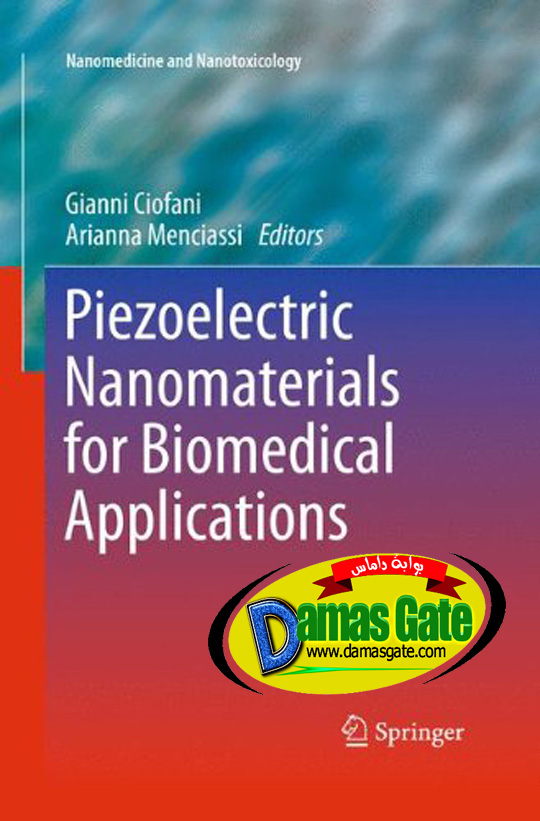Piezoelectric Nanomaterials for Biomedical Applications

Preface
Due to their peculiar properties, piezoelectric materials have found extremely wide applications in the fields of electrical, ultrasonic, robotics, energy conversion,
medicine, space, domestic industries and many others.
This book aims at reviewing piezoelectric phenomena at the nanoscale, with particular attention to biomedical and nanomedicine applications.
The first Chapter presents a general introduction to “smart materials”. Smart materials are able to change some of their properties in response to an external stimulus or to a changes in surrounding environment conditions. In the latest years these materials have gained considerable attention in the biomedical community because of the potential applications in a multitude of active structures and devices. A short introduction to smart
materials is provided, as well as a summary of recent related achievements in biomedicine.
The second Chapter is dedicated to the preparation of piezoelectric nanoparticles, with emphasis on Pb(Zr x Ti 1-x )O systems, detailed descriptions of the most common methods of synthesis (ball milling, mechanicochemical synthesis, coprecipitation technique, hydrothermal method and sol-gel route) are approached, in order to give a comprehensive overview of the enabling manufacturing technologies.
Nanoscale structures and materials have been explored in many biological applications because of their novel and impressive physical and chemical properties. Such properties allow remarkable opportunities to study and interact with complex biological processes. This book analyses the state of the art of piezoelectric nanomaterials and introduces their applications in the biomedical field. Despite their impressive potentials, piezoelectric materials have not yet received significant attention for bio-applications. This book shows that the exploitation of piezoelectric nanoparticles in nanomedicine is possible and realistic, and their impressive physical properties can be useful for several applications, ranging from sensors and transducers for the detection of biomolecules to sensible substrates for tissue engineering or cell stimulation.
English -- ISBN: 3642280439 -- 2012 -- 260 pages -- PDF -- 14,5 MB
Download
http://s18.alxa.net/s18/srvs2/02/003...plications.rar

Preface
Due to their peculiar properties, piezoelectric materials have found extremely wide applications in the fields of electrical, ultrasonic, robotics, energy conversion,
medicine, space, domestic industries and many others.
This book aims at reviewing piezoelectric phenomena at the nanoscale, with particular attention to biomedical and nanomedicine applications.
The first Chapter presents a general introduction to “smart materials”. Smart materials are able to change some of their properties in response to an external stimulus or to a changes in surrounding environment conditions. In the latest years these materials have gained considerable attention in the biomedical community because of the potential applications in a multitude of active structures and devices. A short introduction to smart
materials is provided, as well as a summary of recent related achievements in biomedicine.
The second Chapter is dedicated to the preparation of piezoelectric nanoparticles, with emphasis on Pb(Zr x Ti 1-x )O systems, detailed descriptions of the most common methods of synthesis (ball milling, mechanicochemical synthesis, coprecipitation technique, hydrothermal method and sol-gel route) are approached, in order to give a comprehensive overview of the enabling manufacturing technologies.
Nanoscale structures and materials have been explored in many biological applications because of their novel and impressive physical and chemical properties. Such properties allow remarkable opportunities to study and interact with complex biological processes. This book analyses the state of the art of piezoelectric nanomaterials and introduces their applications in the biomedical field. Despite their impressive potentials, piezoelectric materials have not yet received significant attention for bio-applications. This book shows that the exploitation of piezoelectric nanoparticles in nanomedicine is possible and realistic, and their impressive physical properties can be useful for several applications, ranging from sensors and transducers for the detection of biomolecules to sensible substrates for tissue engineering or cell stimulation.
English -- ISBN: 3642280439 -- 2012 -- 260 pages -- PDF -- 14,5 MB
Download
http://s18.alxa.net/s18/srvs2/02/003...plications.rar